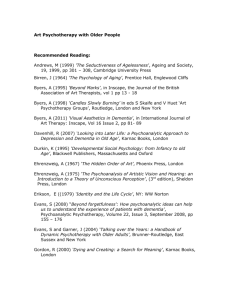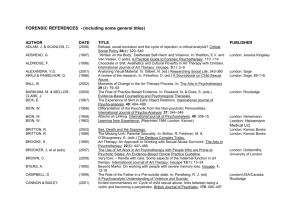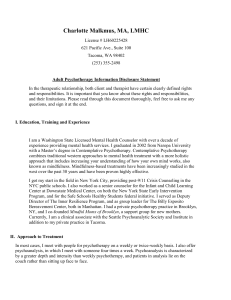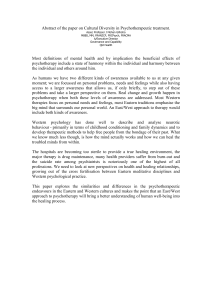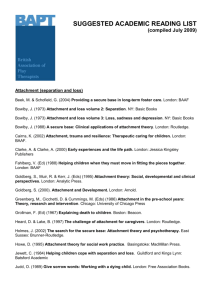Bibliography - Forensic Arts Therapies Advisory Group
advertisement
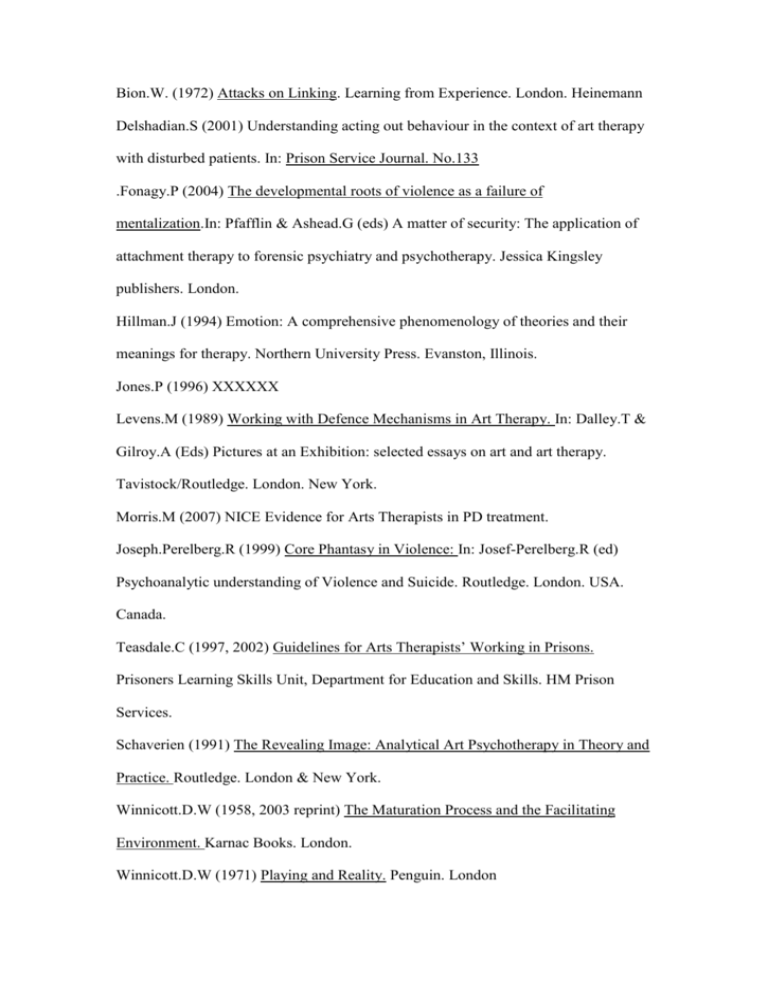
Bion.W. (1972) Attacks on Linking. Learning from Experience. London. Heinemann Delshadian.S (2001) Understanding acting out behaviour in the context of art therapy with disturbed patients. In: Prison Service Journal. No.133 .Fonagy.P (2004) The developmental roots of violence as a failure of mentalization.In: Pfafflin & Ashead.G (eds) A matter of security: The application of attachment therapy to forensic psychiatry and psychotherapy. Jessica Kingsley publishers. London. Hillman.J (1994) Emotion: A comprehensive phenomenology of theories and their meanings for therapy. Northern University Press. Evanston, Illinois. Jones.P (1996) XXXXXX Levens.M (1989) Working with Defence Mechanisms in Art Therapy. In: Dalley.T & Gilroy.A (Eds) Pictures at an Exhibition: selected essays on art and art therapy. Tavistock/Routledge. London. New York. Morris.M (2007) NICE Evidence for Arts Therapists in PD treatment. Joseph.Perelberg.R (1999) Core Phantasy in Violence: In: Josef-Perelberg.R (ed) Psychoanalytic understanding of Violence and Suicide. Routledge. London. USA. Canada. Teasdale.C (1997, 2002) Guidelines for Arts Therapists’ Working in Prisons. Prisoners Learning Skills Unit, Department for Education and Skills. HM Prison Services. Schaverien (1991) The Revealing Image: Analytical Art Psychotherapy in Theory and Practice. Routledge. London & New York. Winnicott.D.W (1958, 2003 reprint) The Maturation Process and the Facilitating Environment. Karnac Books. London. Winnicott.D.W (1971) Playing and Reality. Penguin. London Reynold, M. (2000) The Effectiveness of Art Therapy: Does it Work? In: Art Therapy: Journal of the American Art Therapy Association. Vol.17, No.3, pp.207-13 Review of empirical evidence pertaining to Art Therapy. Schutt, H. & deKeijsor, J. (1996) Cross-Modality Grief Therapy: Description and Assessment of a New Program. In: Journal of Clinical Psychology. Vol.52, No. 3, pp.357-365 Empirical assessment of combined Art Therapy and Behavioural Therapy. Waller, S. (1992) Art Therapy with Adult Female Incest Survivors. In: Art Therapy: Journal of the American Art Therapy Association. Vol. 9. No.3, pp.135-138 Comparative study between verbal therapy, Art Therapy and control group. Ball, B. (2002) Moments of Change in the Art Therapy Process. In: The Arts in Psychotherapy. Vol.29, pp.79-92 Observational research into therapist/client interactions. Brooke, S. (1995) Art Therapy: An Approach to Working with Sexual Abuse Survivors. In: The Arts in Psychotherapy. Vol.22, No.5, pp.447-466 Investigation into changes to reported self-esteem within an Art Therapy group and a control group. Crespo, V, (2003) Art Therapy as Approach for Working with Schizophrenic Patients. In: International Journal of Psychiatry. Vol.8, No.3, pp.183-193 Anecdotal and theoretical account of Art Therapy with schizophrenia. Johns, S. & Karterud, S. (2004) Guidelines for Art Group Therapy as Part of a Day Treatment Program for Patients with Personality Disorders. In: Group Analysis. Vol.37, No.3, pp.432-434 Article in response to research suggesting art based interventions are effective with clients classed as having a personality disorder. Matto, H. (1997) An Integrative Approach to the Treatment of Women with Eating Disorders. In: The Arts in Psychotherapy. Vol.24, No.4, pp.347-354 Anecdotal account of Art Therapy combined with CBT in the treatment of anorexia symptoms. Reharia-Hanauer, D. (2003) Identifying Conflicts of Anorexia Nervosa as manifested in the Art Therapy Process. In: The Arts in Psychotherapy. Vol.30, pp.137-149 Participant/observer qualitative account of behavioural indication occurring within Art Therapy with an anorexic client. Saunders, E. & Saunders,J. (2000) Evaluating the Effectiveness of Art therapy Through a Quantitative, Outcomes-Focused Study. In: The Arts in Psychotherapy. Vol.27, No.2, pp.99-106 Description of Quantitative research methodology as applied to Art Therapy with children, measuring pre and post behavioural indicators. Compiled by Jamie Lofts University of Derby 2005 Bennink.D.E, Gussak and Skowran.M The role of the art therapist in a juvenile Justice Setting. The Arts in Psychotherapy 30 (2003) (3), pp 163-173 Bergenda.J (2000) Current approaches in DramaTherapy Cleven.G & Smeijesters.H (2004) The treatment of aggression using Arts Therapies in Forensic Psychiatry: results of a qualitative inquiry. KenVale Centre of expertise for the arts Therapies, Zuyd University, the University of Professional education Utrecht, and Saxion University of Professional Education Enschede. Gerber.J (1994) The use of art therapy in juvenile sex offender specific treatment The Arts in Psychotherapy 21 (1994) (5) pp 367-374 Gilroy.A & Lee.C (1995) Art and Music Therapy and Research. London & New York Gussak.D (1997) Breaking through barriers: Art Therapy in prisons. In: Gussack.D & Virshup.E (eds) drawing time: Art Therapy in prisons and other correctional settings. Magnolia Street. Chicago IL. Jones.K & Richardson.P (2004) An exploratory randomised trial of group based art therapy as an adjunctive treatment in severe mental illness. Unpublished. Kampen.E (2001) Treatment module creative art therapy. Treatment program 3 sexual disturbances. Chain of offence group. Venray: De Rooyse Wissel. Killick.K & Greenwood.H (1995) Research in Art Therapy with people who have psychotic illnesses. In: Gilroy.A & Lee.C (eds) Art and music therapy and research. Routledge. London & New York. Liebmann.M (1996b) The violent illusion: Drama Therapy and the dangerous voyage to the heart of change. In: Liebmann.M (ed) Arts approaches to conflict. Jessica kingsley Publishers. London. Liebmann.M (1998) Art Therapy with offenders. Jessica Kingsley Publishers. London. Orr.M, McGinley, Jennings.S Dramatherapy Theory and practice 3: Research Event at Broadmoor. Reiss.D, Quayle.M, Brett.T, Meux.C (1998) Dramatherapy for mentally disordered offenders: changes in levels of anger. Whurr Publishers Ltd. Riches.C (1998) The hidden therapy of a prison art education programme. In: Liebmann.M (ed) Art Therapy and offenders. Jessica Kingsley Publishers. London. Ruddy.R & Milnes.D (2002) Art Therapy for schizophrenia or schizophrenia-like illnesses. The Cochrane Library, Issue 3, 2004. Chichester.UK Saunders.e.J & Saunders.J.A (2000) Evaluating the effectiveness of Art Therapy through a quantitative outcomes-focussed study. The arts in Psychotherapy 27 (2) 99106 Teasdale C (1997) Art Therapy as part of a group therapy programme for personality disordered offenders. Therapeutic communities: The International Journal for therapeutic and supportive organisations 18 (3) pp 209-221. Teasdale .C (1997) Art Therapy as a shared forensic investigation. International Journal of Art Therapy. Inscape. 2 No 2. Wood.C (1997) The history of Art Therapy and psychosis (1938-95) In: Killick.K, Schaverien.J (Eds) Art Psychotherapy and psychosis. Routledge. London & New York. ART THERAPY WITH OFFENDERS READING LIST – A SELECTION Books Carrell, C. and Laing, J. (eds) (1982) The Special Unit, Barlinnie Prison. Glasgow: Third Eye Centre. Gussak, D. and Virshup, E. (eds) (1997) Drawing Time: Art Therapy in Prisons and Other Correctional Settings. Chicago: Magnolia Street Publishers. Liebmann, M. (ed) (1994) Art Therapy with Offenders. London: Jessica Kingsley Publishers. (Including authors Aulich, Baillie, Cronin, Edwards, Hagood, Liebmann, Mackie, McCourt, Murphy, Riches) Chapters and articles Hagood, M. (2000) ‘The Use of Art in Counselling Adolescent Sex Offenders’ and ‘The Use of Art in Group Work with Adolescent and Adult Sex Offenders’, Chapters 8 and 9, in The Use of Art in Counselling Child and Adult Survivors of Sexual Abuse. London: Jessica Kingsley Publishers. Klugman, S. (1999) ‘Art Therapy and Art Education within a Secure Setting.’ Inscape, Vol 4, No. 1, 29-34. Laing, J. (1984) ‘Art Therapy in Prisons.’ In T. Dalley (ed) Art as Therapy: An introduction to the use of art as a therapeutic technique. London: Tavistock. Liebmann, M. (1990) ‘ “It Just Happened”: Looking at Crime Events.’ In M. Liebmann (ed) Art Therapy in Practice. London: Jessica Kingsley Publishers. Liebmann, M. (1998) ‘Art Therapy with Offenders on Probation.’ In D. Sandle (ed) Development and Diversity: New Applications in Art Therapy. London and New York: Free Association Books. Liebmann, M. (2004) Art Therapy for Groups, 2nd edition. London: BrunnerRoutledge. Has short excerpt in Chapter 6, Example 11 ‘Day centre for ex-offenders.’ Liebmann, M. (forthcoming) ‘Anger Management Group Art Therapy for Clients in the Mental Health System.’ In F. Kaplan (ed) Art Therapy and Social Action: Treating the World’s Wounds. London: Jessica Kingsley Publishers. Locke, L. (1998) ‘The Black Madonna in New Mexico Prison Art.’ In A. Hiscox and A. Calisch (eds) Tapestry of Cultural Issues in Art Therapy. London: Jessica Kingsley Publishers. McKenzie, K., Chisholm, D. and Murray, G. (2000) ‘Working with Sex Offenders Who Have a Learning Disability.’ Inscape, Vol 5, No. 2, 62-69. Tamminen, K. (1998) ‘Exploring the Landscape Within - Art Therapy in a Forensic Unit’. In D. Sandle (ed) Development and Diversity: New Applications in Art Therapy. London and New York: Free Association Books. Teasdale, C. (1995) ‘Reforming Zeal or Fatal Attraction – Why should art therapists work with violent offenders?’ Inscape, Vol 2, 2-9. Teasdale, C. (1997) ‘Art Therapy as a Shared Forensic Investigation.’ Inscape, Vol 2, No. 2, 32-40. Other resources Journals with occasional articles on work with offenders: Inscape (the Journal of the British Association of Art Therapists) Arts in Psychotherapy (an American/ international journal) Forensic Arts Therapies Advisory Group (FATAG) FATAG is a voluntary organization which aims to provide support, advice and opportunities for continuing professional development for arts therapists (art, music, drama and dance movement therapists) working in forensic or secure settings (prisons, mental health secure units, etc). FATAG can sometimes disseminate enquiries through their e-mail network. Postal address: PO Box 40032, London N6 4WJ E-mail: fatag@blueyonder.co.uk Web site: www.fatag.org.uk Ann Peaker Centre for Arts in Criminal Justice Promotes and supports the use of the arts in criminal justice. Has a directory of arts organizations working in prisons and Young Offender Institutions. Postal address: Neville House, 90-91 Northgate, Canterbury, Kent CT1 1BA Tel: 01227 470629 E-mail: info@apcentre.org.uk Web site: www.apcentre.org.uk Recommended reading: Bion.W.R (1984) Learning from Experience. Routledge. London Dalley.T. et. al (1987) Images of Art Therapy: New Developments in Theory & Practice. Tavistock Publications. London & New York. Jones.D (Ed) (2004) Working with Dangerous People. The psychotherapy of violence. Radcliffe Medical Press. Oxford. San Francisco. Liebmann.M.ed (1994) Art Therapy with Offenders. Jessica Kingsley Publishers. London & Bristol, Pennsylvania. Welldon.V.Estela (1992/2000) Mother, Madonna, Whore: The Idealisation and Denigration of Motherhood. Other Press. New York. Articles: Bick.E. (1968) The Experience of the skin in early object relations. International Journal of Psycho-Analysis. 49, 484. Glasser.M (1998) On Violence. A Preliminary Communication. International Journal of Psychoanalysis. 79. Teasdale.C Art Therapy as a Shared Forensic Investigation. Inscape Volume Two No: 2 1997. Teasdale.C Reforming Zeal or Fatal attraction: Why should art therapists work with violent offenders? Inscape Vol 2 1995 Bibliography Asch (1980) Suicide and the hidden executioner. International Review of Psychoanalysis. 7. 51-60 Bateman.A and Fonagy.P (2004) Mentalisation-Based Treatment of BPD. Journal of Personality Disorder. 18. (1) 36-51. Bion.W (1962) Learning from experience. Heinemann. London. Bion.W.(1967) Attacks on Linking. In: Second Thoughts. Selected papers on Psychoanalysis. Mansfield Library. London. Campbell.D and Hale.R (1991) Suicidal Acts.In: Holmes.J (Ed) Textbook of Psychotherapy in Psychiatric Practice. Churchill. Livingstone. Campbell.D (1999) The Role of the Father in a Pre- Suicidal State. In: Perelberg.R.J. (Ed).Psychoanalytic Understanding of Violence and Suicide.. Routledge. London. New York. Canada. Conger. D (1988) Suicidal Youth; The challenge to art therapy. The American Journal of Art Therapy. 27. 34-44 Delshadian.S (2001) Understanding Acting Out Behaviour in the Context on Art Therapy with Disturbed Patients. In: Prison Service Journal. No.133 Fonagy .P and Target.M (1999) Towards understanding violence. The use of the body and the role of the father. The New Library of Psychoanalysis Freud.S (1917) Mourning and Meloncholia. In: Introductory Lectures in Psychoanalysis. Standard Edition. 14. Hogarth Press. Pp 237-266. Freud.S (1926) Inhibitions, Symptoms and Anxiety. Standard Edition. 20. Hogarth Press. Pp 77-175. Freud.S (1964) Civilisation, Society and Religion. Group Psychology, Civilisation and its Discontents and Other Works. Penguin. London. Glasser.M (1979) Some aspects of the role of aggression in the perversions. In:Rosen.I.(Ed) Sexual deviation. Oxford University Press. Glasser.M (1998) A Preliminary Communication. International Journal of Psychoanalysts 79.pp 887. Hale.R (2005) ‘On Suicide’.16th Forensic Arts Therapies Advisory Group Conference. Belsize Place. London. Harden B, Rosales, A & Greenfield, B (2004) Outpatient art therapy with a suicidal adolescent female. The Arts in Psychotherapy, 31. 165-180. Hawton, K., et al. (1998) Deliberate self harm: Systematic review of psychosocial and pharmacological treatments in preventing repetition. British Medical Journal, 317: 441-446 Honig.S. (1975) The ideation of art work of suicidal patients. Art Psychotherapy. 2. 77-85. Klein.M (1977) Envy and Gratitude and Other works. Delta. New York. Levens.M (1989) Working with Defence Mechanisms in Art Therapy. In: Dalley.T & Gilroy.A (Eds) Pictures at and Exhibition: selected essays on art and art therapy. Tavistock/Roputledge. London. New York Lucas.R. (2003) Risk assessment in general psychiatry: a psychoanalytic perspective. In: Doctor.R (Ed) Dangerous Patients: a psychodynamic approach to risk assessment and management. Forensic Psychotherapy Monograph series. Karnac. London. MacClagan.D Re-Imagining art therapy. International Journal of Art Therapy. June 2005. 10 (1):23-30. Morgan,G., Buckley,C, & Nowers,M. (1998). Face to face with the suicidal. Advances in Psychiatric Treatment, 4: 188-196 Rothwell.K (2005) . ‘Lost in Translation: Art Therapy and Suicide’. 16th Forensic Arts Therapies Advisory Group Conference. Belsize Place. London. Rothwell.K (forthcoming) What Anger? Working with acting out behaviour in secure settings. In: Liebmann.M (Ed) Art Therapy and Anger. Jessica Kingsley Publishers. London.Philadelphia. Rothwell.K (2006) Art Therapy with Violent Offender Patients. MA in Advanced Clinical Practice in Art Psychotherapy. PACE. Goldsmiths College, University of London. Schachtler.J (1991) The paradox of suicide: issues of identity and separateness. In: Perelberg.R.J. (Ed).Psychoanalytic Understanding of Violence and Suicide.. Routledge. London. New York. Canada Shaw.J, Appleby.L, Baker.D. Safer Prisons. A National Study of Prison Suicide 1999-2000 by the National Confidential Inquiry into Suicides and Homicides by people with Mental Illness. Department of Health Document. Winnicott.D.W (1967) Mirror-role of the mother and family in child development. In: Lomas.P (Ed) The Predicament of the Family. A Psychoanalytic Symposium. Hogarth. London. Pp 26-33. References Bowlby, J. (1988) A Secure Base. London: Routledge. Freud, S. (1964) Civilization, Society and Religion, Group Psychology, Civilization and its Discontents and Other Works. London: Penguin Books. Levens, M. (1989) ‘Working with defence mechanisms in art therapy.’ In A. Gilroy and T. Dalley (eds) Pictures at an Exhibition. London: Routledge. Rabiger, S. (1990) ‘Art therapy as a container.’ In C. Case and T. Dalley (eds) Working with Children in Art Therapy. London: Routledge. Teasdale, C. (1995) ‘Reforming zeal or fatal attraction: Why should art therapists work with violent offenders?’ Inscape 2, 2 –9. Williams-Saunders, J. (ed) (2001) Life within Hidden Worlds. London: Karnac Books. Winnicott, D.W. (1971) Playing and Reality. London: Penguin. Winnicott, D.W. (1986) Home is where we start from: Essays by a Psychoanalyst. London: Penguin. Further reading Aulich, L. (1994) ‘Fear and loathing: art therapy, sex offenders and gender.’ In M. Liebmann (ed) Art Therapy with Offenders. London: Jessica Kingsley Publishers. Dalal, F. (2002) Race, Colour and the Process of Racialisation: New Perspectives from Group Analysis, Psychoanalysis and Sociology. London: Brunner-Routledge. Symington, N. (1996) ‘The origins of rage and aggression.’ In C. Cordess and M. Cox (eds) Psychodynamics and the Offender Patient. London: Jessica Kingsley Publishers.
